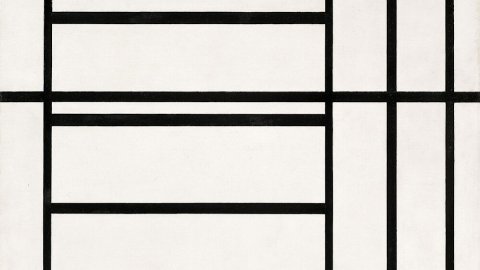Among the works most loved by the public, Composition no. 1 with gray and red 1938 / Composition with red 1939 it has the ability to capture the observer's gaze thanks to the harmonic balance given by the rhythm and purity of the shapes and by the intersection between horizontal and vertical lines.
After the restoration of Alchemy (1947) by Jackson Pollock, de A systematic review (1928) by Pablo Picasso and the Box in a suitcase (1941) by Marcel Duchamp, it will therefore be another icon of XNUMXth-century art from Peggy Guggenheim's collection that will be examined. The study of the work is essential for a full understanding of the materials and techniques adopted by Mondrian, and retracing the historical stages of its conservation is a further guiding element in view of a possible restoration intervention.
The double title refers to a reworking of the work by the artist. Scientific investigation will determine the location of the gray color in the first version of the painting, Composition no. 1 with Gray and Red from 1938, later removed by the artist himself, with the consequent change of the title to Composition no. 1 with gray and red 1938 / Composition with red 1939. In 1943 Max Bill, architect, designer friend of Mondrian, to whom the artist often sent images of the progress of his works, including one of Composition with Red, writes that the first version of the work included a small gray box in the upper left. During a conversation with Angelica Rudenstine, author of the catalog raisonné of the Peggy Guggenheim Collection, it is the same American patron, who acquired the work in November 1939, who suggests that Mondrian would have modified the painting in New York, before the opening of the gallery - Art of This Century museum, in 1942, and that therefore this change could have occurred between 1941 and precisely 1942. However, in a reproduction of the work on the London Bulletin from 1939, the painting already seems to have been reworked given the absence of the gray box. It therefore remains possible that Mondrian intervened again on the work before the inauguration of Art of This Century, without, however, drastically altering its composition as in the intervention of '39. The artist used to return to his paintings by perfecting the black of the lines and the subtle shades of white.
Composition no. 1 with gray and red 1938 / Composition with red 1939 it is one of the few paintings on which the Dutch artist worked during his two-year stay in London, between 1938 and 1940on the eve of the outbreak of World War II. These were years in which Mondrian tried to abandon his subjectivity as much as possible. This need may lead to interpret the simplicity of the works of this period as a response to the further complications of that era. In this light, the painting assumes great historical importance, as a manifesto of the simplified aesthetics of Neoplasticism. It is in fact one of the most reductive compositions from a chromatic point of view, severe and austere and, at the same time, an intuitive work and an abstract scheme of uncertainty and the search for order in one of the most difficult periods of our history.
It is precisely in London, in 1938, that Peggy Guggenheim she remains fascinated by Mondrian's work, so much so that the artist becomes one of the main points of reference in the circle of avant-garde artists who punctuate the collector's life. There are numerous anecdotes that characterize their unique friendship, such as the Mondrian's passion for dance, although the artist was already seventy at the time, listening to jazz and participating in social events and parties, as the patron herself recounts in her autobiography A life for art (Rizzoli Editori, Milan, 1998).
The interdisciplinary study project will be coordinated by Luciano Pensabene Buemi, curator of the Collection, which will carry out the restoration of the work and will supervise the collaboration with the ISPC, Institute of Cultural Heritage Sciences, and SCITEC, Institute of Chemical Sciences and Technologies of the CNR, National Research Council, which will be involved with the most advanced technologies put developed for the non-invasive study of the canvas in situ. The scientific analyzes will allow the identification of the materials and techniques used by Mondrian and will allow constant monitoring of the painting during the restoration. The study will involve the conservation and curatorial departments of the Peggy Guggenheim Collection and the Solomon R. Guggenheim Museum in New York. Overseeing the project will be Lena Stringari, Deputy Director and Andrew W. Mellon, Chief Curator of the Solomon R. Guggenheim Foundation, along with Gillian McMillan, Chief Associate Conservator of the Solomon R. Guggenheim Museum, bringing their previous experience on the works by Mondrian. Comparative study with unrestored paintings by the artist and dialogue with experts in the field, including curators, art historians, conservators and scientists, will be crucial to this project. This research, together with the interdisciplinary dialogue, will guarantee the well-thought-out and aware of the related problems restoration of a masterpiece of twentieth-century art such as Composition no. 1 with gray and red 1938 / Composition with red 1939.





